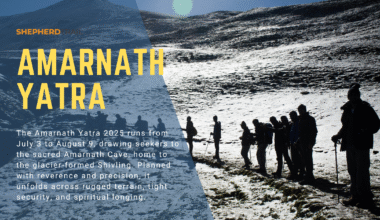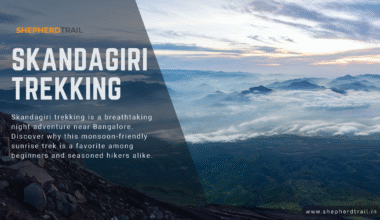🌄 Manimahesh Yatra Trek – A Pilgrim’s Journey Through Himalayan Devotion
When Mountains and Devotion Become One
The Manimahesh Yatra Trek isn’t just another mountain path—it’s a pilgrimage steeped in legend and devotion. Nestled deep within Himachal Pradesh, this journey blends forest trails, alpine meadows, sacred bathing pools, and a pristine high-altitude lake cradled under the “Shivling-shaped” peak of Manimahesh Kailash.
It’s a trek where every step resonates with prayers, shepherd songs, and mountain breezes. For those seeking more than just alpine scenery, this trek offers a chance to feel the pulse of Himalayan faith.
What Makes Manimahesh Trek Unforgettable
🕉️ Spiritual Pilgrimage in Every Turn
During Janmashtami to Radhashtami (late August–early September), pilgrims from around the region gather—walking in chhari (prayer staff), singing folk hymns, and bathing in sacred pools. These rituals transform the trek into a collective soulful experience.
🏞️ Scenic, Yet Surprising
Towering evergreens, bubbling brooks, vibrant meadows, and misty waterfalls—all lead to a jewel-like lake that mirrors a snow-draped peak shaped like a Shivling. The surroundings feel both raw and sacred.
🧭 Options for Every Trekker
-
Standard Route (Hadsar–Lake): A 2–3 day trek accessible to most, ideal for families and spiritual seekers.
-
Kugti Pass Loop: A 4–5 day wilderness trek around Kugti Wildlife Sanctuary—great for fit hikers.
-
Heli to Gauri Kund: A 1 km final walk from helicopter drop—perfect for those with limited time or mobility.
Which Route Is Right for You?
A) Hadsar → Dhancho → Manimahesh Lake (Classic Pilgrimage Route)
-
Distance & Altitude: ~13 km; starts at 2,040 m, ends around 3,950 m
-
Duration: 2 nights, 3 days
-
Trail Highlights: Pine forests, open meadows, waterfall camps, and the sacred lake
-
Why Choose It: Easily accessible, steeped in spiritual atmosphere, doable with moderate fitness
B) Kugti Pass – For the Adventurous
-
Distance & Altitude: ~35–40 km loop, with passes over 4,000 m
-
Duration: 4–5 days
-
Highlights: Glacier views, wildlife zones, remote camping far from crowds
-
Why Choose It: More challenging terrain and rich natural biodiversity
C) Helicopter to Gauri Kund + Short Walk
-
Duration & Distance: 1–2 hours on foot
-
Who Is It For: Elderly, visually impaired, or anyone seeking a short pilgrimage route
Detailed 5-Day Itinerary (Classic Route)
🗓 Day 0 – Arrival & Cultural Pulse in Bharmour
Drive into peaceful Bharmour, explore its ancient temples, and listen to Gaddi shepherd folk tunes under bejeweled temple ceilings.
🗓 Day 1 – Hadsar to Dhancho
Drive up to Hadsar early, begin your 6 km trek through lush forest and riverside trails, and camp beside meadows near a waterfall.
🗓 Day 2 – Final Push to the Lake
Cross the mountain saddle known as “Bandar Ghati,” reach the sacred lake in the afternoon, take a ritual dip in gendered pools, and join communal evening prayers.
🗓 Day 3 – Lake to Bharmour
Sunrise dip, last gazes of the lake and peak, descent through Dhancho and Hadsar, and a return drive to Bharmour.
🗓 Day 4 – Bharmour to Exit
Spend a final morning in Bharmour—temple visits or local storytelling—before heading onward.
When to Go & What Permits You Need
-
Best Time: August–early September during Yatra for festival atmosphere; June–October for quieter trekking
-
Permits:
-
Yatra Season: Mandatory registration and medical check in Bharmour/Hadsar
-
Kugti Route (off-season): Forest permit; foreign nationals may need Inner Line Permit
-
-
Yatra Ends: Around Radhashtami (typically early September each year)
Spiritual Traditions & Sacred Customs
-
Temple Dip Sites: Women bathe at Gauri Kund; men at Shiv Karotri—separate pools echoing deep-seated traditions
-
Circumambulation: Pilgrims often circle the lake three times, singing hymns and offering prayers
-
Pilgrim Chhari: Walking with a prayer staff, singing devotion hymns during camp walks and pauses
Flora, Fauna & Natural Treasures
-
Forest Zones: Cedar, pine, and birch forests filled with birdlife and the murmurs of mountain streams
-
Alpine Beauty: Meadows bloom with rhododendron and primula—especially vibrant in late July and early August
-
Wildlife: Kugti Pass route may offer sightings of Himalayan monal, bharal, and even elusive snow leopards
Health, Safety & Eco-Respect
⛰ Altitude Preparedness
Stay well hydrated, take it slow, and be alert for signs like headaches or nausea. Descend if needed—mountains don’t pressure, people do.
🌦 Weather Awareness
Carry layers—quick‑dry base, fleece, waterproof shell—and pack both day and night warmwear. Monsoon periods bring sudden rain and low clouds.
🚰 Eco Stewardship
Leave only footprints—carry out all waste, avoid plastics, and respect sacred or wildlife areas.
♻️ Local Norms
Stay on trails, respect customs, and treat livelihood spaces (villages, shrine zones) with kindness and gratitude.
What to Pack: Essential Kit List
| Category | Item Examples |
|---|---|
| Clothing | Moisture-wicking top, fleece, down jacket, rain gear |
| Footwear | Sturdy trekking boots, extra socks |
| Gear | Trekking poles, daypack, sleeping bag (or rent), headlamp |
| Hydration & Energy | 2 L bottles, purification tablets, high‑energy snacks |
| Spiritual Kit | Prayer staff (chhari), light chador, personal towel |
| Protection & Health | Sunglasses, SPF 50+, altitude medicine, first aid, hand sanitiser |
| Documents | ID, Yatra permit or health certificate, forest permit (if applicable) |
| Misc | Trash bags, zip-lock liners, optional power bank |
Budget Snapshot
-
Transport (delhi to Bharmour): ₹2,000–₹3,000 by bus/car
-
Camping & Meals: Free community langars, ₹100 for extra dhaba meals
-
Horse/Palki (optional): ₹2,000–₹6,000
-
Helipad Option: ₹4,500–₹9,000 per trip
-
Forest Permits: Nominal fees at sanctuary gates
Total cost ranges from ₹4,000–₹10,000, depending on optional services like horses or helicopter ride.
Who Should Trek This?
✅ Soulful seekers of Himalayan pilgrimage
✅ Moderately fit hikers comfortable with 5–7 km/day
✅ Culture enthusiasts drawn to folk, ritual, and community
❌ Not advised for those with high-altitude sickness history or unable to walk moderate uphill terrain
ShepherdTrail Tips for a Meaningful Trek
-
Visit Temples in Bharmour: A blessing before dawn sets the day’s spiritual tone
-
Confirm Your Yatra Date: Health checkups and mass registrations build pilgrim safety
-
Arrive a Day Early: Buffer the first trek segment to avoid altitude stress
-
Share a Chhari Melody: Join in the communal hymns during evening prayers
-
Honor the Meadows: Use existing fire pits, and leave them pristine
-
Chat with the Gaddis: Their legends enrich your journey with Himalayan lore
-
Capture without Crowding: Focus on emotional moments, not just selfies
Stories from Travelers & Locals
A Bangalore trekker shared how the nightly langar tents offered both food and community warmth:
“Despite the trek’s challenge, the kindness of strangers and nightly song circles around the fire made every step divine.”
A Gaddi shepherd visiting Manimahesh over decades said:
“I come with my chhari, chant and hike. The lake feels older than mountains—it holds the blessings yet.”
Final Thoughts: Footprints & Faith
The Manimahesh Yatra Trek is a rare blend of spiritual depth and mountain adventure. It’s a trek for the humble pilgrim and mindful hiker—a place where devotion walks side by side with scenic wonder.
Whether you hike up slowly, stay up for sunrise, or sit by the mirror-calm lake—it’s a journey that stays in your body and memory long after descent.
🔗 Ready for the Sacred Step?
Check out our detailed packing guide, the gear we recommend, and live updates from the trail at ShepherdTrail, where every trip tells its own story.







